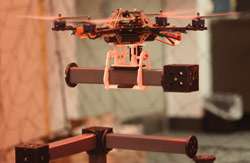Flying machines are YouTube sensation

(PhysOrg.com) -- The latest YouTube sensation isn’t a puppy that dances to Lady Gaga or a kitten that opens beer bottles. By using unmanned aerial vehicles called quadrotors, two Ph.D. candidates at the School of Engineering and Applied Science have built an autonomous airborne construction crew able to build small structures—and in the process they’ve captured the attention of millions.
Mechanical engineering students Quentin Lindsey, 26, and Daniel Mellinger, 25, wrote algorithms that enable the quadrotors to discern which specific building piece to pick up, and where it should be placed.
“This is a paradigm changer,” says Penn Engineering Deputy Dean for Education Vijay Kumar, the students’ advisor. “If you look at robots, they do things from the ground up. Think about how the military uses robots on the ground. For the first time we’re able to build things from the top down. This is really a completely new capability being developed.”
Lindsey and Mellinger began writing the algorithms in Penn’s General Robotics, Automation, Sensing and Perception (GRASP) Lab in November. Just three months later, the quadrotors were able to autonomously construct cubic structures, towers, pyramids and walls.
“We tell it what structure to build, then we have a method that figures out the assembly plan—basically a list of parts and where they go,” Mellinger says. “Then the quadrotors line up and quadrotor one picks up part one and puts it in place, quadrotor two picks up part two and puts it in place, and so on.”
The quadrotors “know” where each part is located, and they’re able to grasp it using a gripper, the students explain. The part, made from plastic or PVC pipe, is attached to the body of the structure using a magnet.
“Obviously you’re not going to go to a construction site right now and see these parts, but these are parts you can modify and conceivably scale up and make them into real parts that you could actually build things with,” Lindsey says.
The project is an initial foray into building more complicated structures with quadrotors and robots.
“Full-size helicopters now are used in real construction projects,” Mellinger says. “To think you might be able to add autonomy to that with robotic quadrotors might not be too far off in the future.”
In the meantime, the video “Construction with Quadrotor Teams” has created quite a stir. Just over two minutes long, it shows a squad of Penn quadrotors snatching up construction parts and building a mini-tower in a lab. The quadrotors sound like a swarm of very intense bees, and watching them go about their work is captivating.
The video has received more than 400,000 hits on YouTube, and television’s popular faux newscaster Stephen Colbert recently featured it during the “ThreatDown” segment of his show “The Colbert Report” on Comedy Central.
“For years I have been warning about the threat of robots rising up against their human masters,” Colbert said during the broadcast. “Scientists have reached a new milestone in our enslavement. Flying robot drones. Today they’re constructing a three-foot tower, tomorrow it’s a sprawling prison for three-foot prisoners.”
While the media attention is flattering and fun, Kumar says it shouldn’t mask the serious science behind the project.
“These robots are completely autonomous, they are not being [remotely controlled],” he explains. “We want to fly into spaces where humans either don’t want to fly or cannot fly. If you can imagine a hostage setting in a building, I can send these guys into the building and they can be the eyes and the ears of rescue personnel outside. I can go into a damaged building after a natural disaster and help victims.”
The researchers say the project may also be a precursor to autonomous robotic construction.
“In our lab we have a lot of experiments and projects that are ground based and we have a lot of experiments that are air based,” Lindsey says. “But we don’t have any that are combined. This is one of the few times where you can actually put the two different kinds of robots together. This is just the first step.”
A successful and satisfying step, Mellinger says. “It’s always fun as an engineer to think about solving a problem and then see it work. It’s just a bonus that it’s gotten so much attention and people like it so much.”
Provided by University of Pennsylvania

















